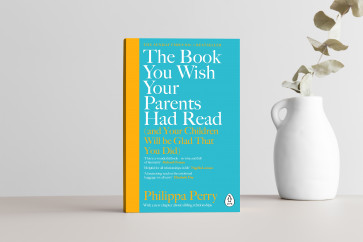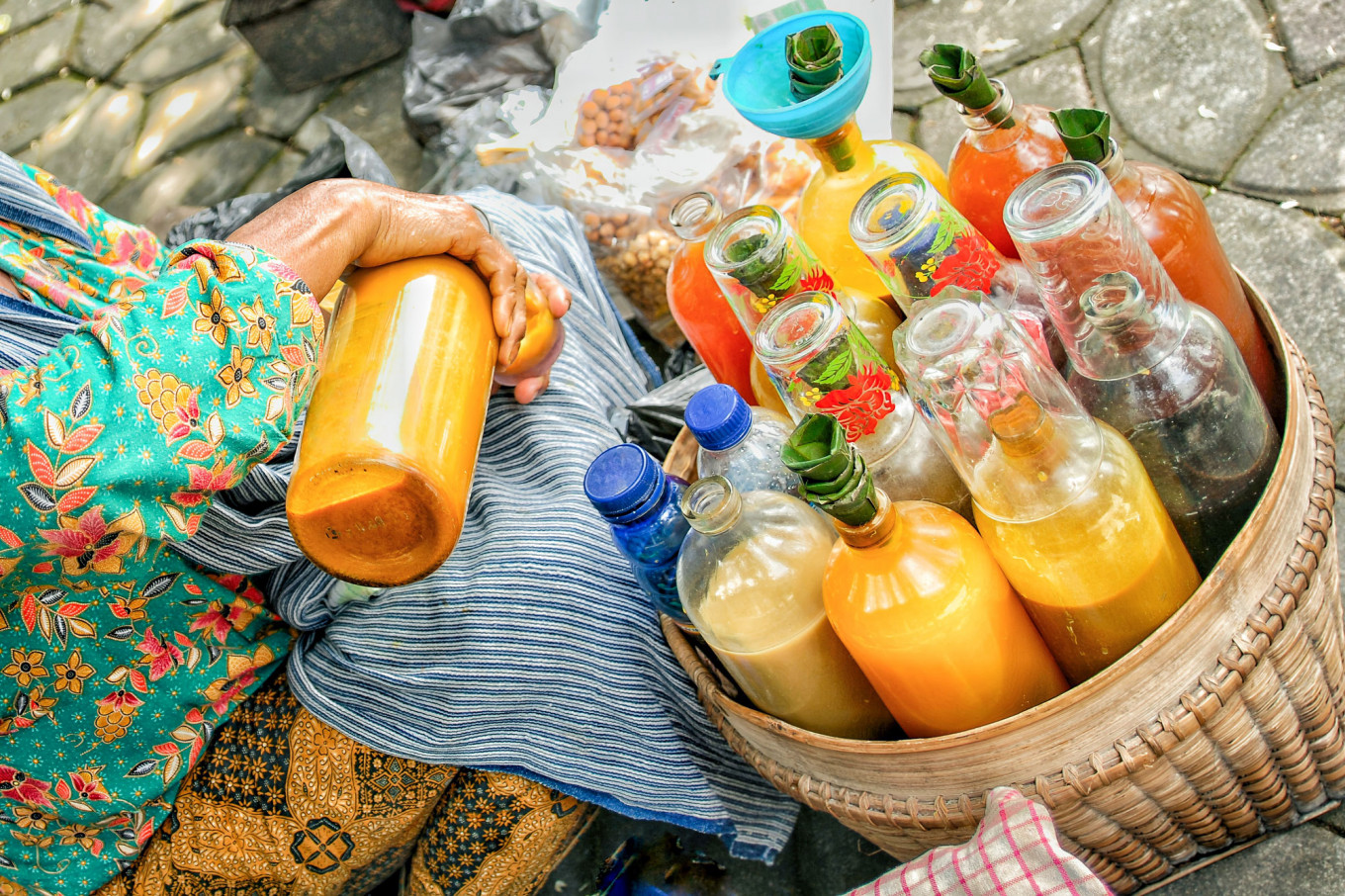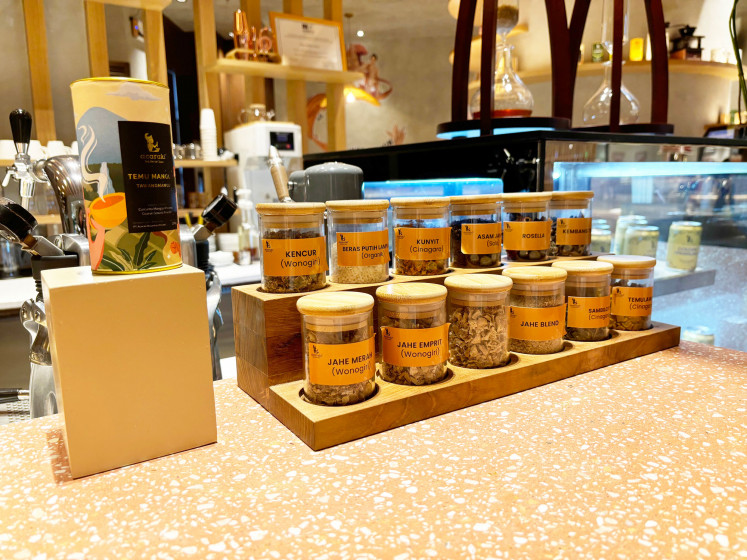(Courtesy of Shutterstock)
Sitting at Acaraki in Grand Indonesia, I watched the guy in front of me pick up a shaker, scoop in some turmeric and lemongrass, add a drizzle of honey and begin shaking the ingredients like a cocktail.
In no time, I had a cup of Alea Smile, one of their bestselling jamu blends, in front of me. This modern take on the traditional herbal medicinal drink was a far cry from the jamu of my childhood, but it was still jamu.
Growing up, jamu was a daily ritual. My brother, cousin and I used to chase the mbok jamu — the jamu woman — at around 7:00 a.m. each morning to get one of the many brews she carried in bottles slung over her shoulders. Fast forward to today, and I can now order a brewed remedy for everything from a sore throat to extra energy, all in a chic café setting.
Jamu has come a long way from its beginnings in the royal courts of the Mataram Kingdom in the 8th century. Once a drink exclusive to royalty, it gradually became a staple among the common people. Today, despite the rise of Western medicine, jamu remains ingrained in Indonesian culture. But can it keep up?
“If we’re talking about traditional herbal medicine, yes, it’s shrinking,” says Mulyo Rahardjo, CEO of PT Deltomed Laboratories. “But that’s because it hasn’t adapted quickly enough. Modern pharmaceutical companies are now producing herbal medicines in more modern forms.”
The traditional practice of jamu gendong — where the mbok jamu would carry bottles door-to-door — may be fading, but the art of jamu is far from extinct. Indonesians have always found ways to reinvent the traditional elixir for a younger, busier generation.

Thank you!
For signing up to our newsletter.
Please check your email for your newsletter subscription.
(Courtesy of Acaraki)
Read also: Jordan Susanto is searching his soulThe ‘yassification’ of jamu
In a world where convenience is king, jamu has evolved from bottles carried in baskets and sold by the glass, to sachets and capsules easily found in stores.
“My father saw the need to make jamu simpler and more convenient because the powder or the brew was too troublesome,” Mulyo explains.
Deltomed launched Pilkita, a capsule form of herbal medicine, in 1988, followed by Antangin, which comes in capsules, gummies and syrups. Aside from being more convenient, these products have a more pleasant flavor than the traditionally bitter versions.
In 1992, PT Industri Jamu dan Farmasi Sido Muncul also packaged its original Tolak Angin recipe from the 1930s into the syrup sachets we know and heavily consume today.
In the digital era, it was no longer just about convenience. Companies like Bakool Jamoo, which has been offering bottled jamu since 2009, realized they needed to rely heavily on social media marketing.
“To attract millennials and Gen Z, our packaging had to be more contemporary,” says founder Adit Sastra, emphasizing the need to make jamu as accessible and attractive as any trendy drink.
In Gen Z lingo, that means they need to “yassify”, or to make traditional drink more visually appealing.
Now, cafés like Acaraki are again redefining how jamu is served. Popular among 20- to 40-year-olds, Acaraki blends traditional ingredients with modern brewing techniques typically reserved for coffee and tea.
Acaraki’s Vanilla Twilight, for instance, looks similar to a modern affogato: light vanilla ice cream paired with the tangy taste of turmeric, served with a tamarind shot to pour over.
(Courtesy of Sheena Suparman)
A niche in prevention
With the rise of modern medicine, jamu has not faded away but instead shifted toward prevention rather than cure, according to Mulyo.
Drinking jamu, he says, “is shifting from being curative to more about prevention, about boosting immunity, maintaining healthy skin, hair and eyes.”
Jamu is now seen as a long-term wellness practice rather than a quick fix, with many consumers ready to attest to its benefits — myself included.
“I’ve heard from many who consume it regularly that they feel their bodies are fitter, they have more energy and they’re less likely to get sick,” adds Wasista from Acaraki.
A 2022 survey by the National Research and Innovation Agency (BRIN) found that 10 percent of respondents still drink jamu daily. The research also concluded that there is significant potential for market growth, especially among younger consumers.
Lonika, a 23-year-old marketing communication officer who has been a jamu drinker since childhood, agrees.
“I think if the current generation — my generation — can actually learn about jamu, they will realize that it’s not just a medicine but can be an everyday drink,” she says.
“It’s very important that we make sure jamu survives and stays relevant in the future.”
Read also: The hype and high of rock climbingSustainability worries
That survival, however, is at risk—not necessarily because of a lack of demand, but because of supply challenges.
The raw materials needed to produce jamu — plants like turmeric and ginger — are becoming scarce. According to the Central Bureau of Statistics (BPS), turmeric production in 2019 only reached 190,909 tonnes, compared to 742,000 tonnes of coffee produced.
With fewer jamu drinkers than coffee and tea drinkers, the land dedicated to growing these essential herbs is shrinking.
To combat this, companies like Acaraki have partnered with farmers in Cinagara village, Bogor, to sustainably source herbs. In 2019, they provided seeds and opened up five hectares of land for medicinal plants, boosting farmers' welfare while preserving the tradition of jamu.
But the challenge remains.
“What happens if future generations get sick and the herbs they need no longer exist because the farmers have switched to growing coffee or tea?” Wasista warns.
That would be disastrous for consumers like Umi, for whom a daily shot of jamu has become a liquid talisman to control her cholesterol levels.
“I rarely take chemical medicines, so I drink herbal medicine. Whatever my illness is, I will immediately drink ginger and turmeric,” she says as she buys a bottle from Adit’s stall during a car-free Sunday in Jakarta.
I nod in agreement as I head off with the four bottles Adit gave me.
Read also: The Thin ObsessionThis article is part of The Weekender, a biweekly tabloid that appears in the Saturday edition of The Jakarta Post. Offering a variety of feature articles on lifestyle and culture, it aims to enriching your reading experience. Subscribe here to access The Jakarta Post’s Saturday edition and all Premium content.

























